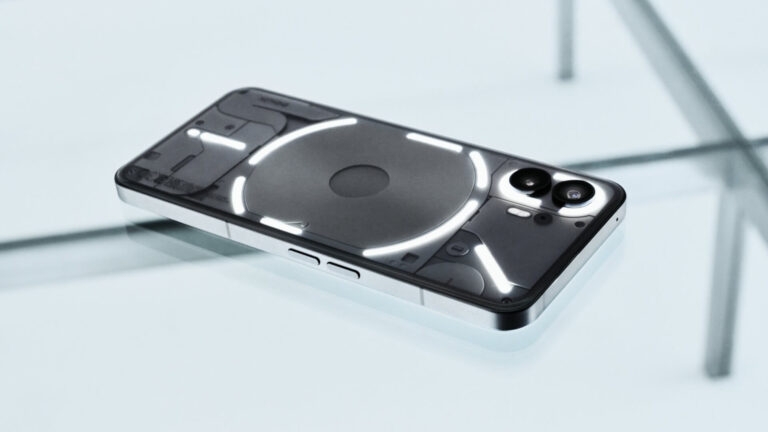Highlights
- The Nothing Phone (2) brings significant improvements with its faster performance, better battery, and improved camera, making it a compelling option for those seeking a new smartphone experience.
- Existing Nothing Phone (1) users may not need to upgrade unless they truly require the enhanced performance and features, as the Phone (1) remains a reliable device with continued software support for at least two more years.
- The Nothing Phone (2) stands out with its larger display, higher screen resolution, and upgraded camera sensor, offering a more immersive visual experience and sharper image quality.

The highly anticipated launch of the Nothing Phone (2) has left tech aficionados debating whether it is indeed worthwhile to upgrade from the predecessor, Nothing Phone (1), in the ever-evolving world of smartphones. The Nothing Phone (2) promises to push the limits of mobile technology with its cutting-edge capabilities, improved performance, and stylish appearance.
This article helps you determine whether the switch from the Nothing Phone (1) to Nothing Phone (2) is a worthwhile investment in your quest for the best smartphone experience by delving into the major advancements and improvements provided by the new model, scrutinizing the potential advantages of upgrading, and finally assisting you in making that decision.
Read: Asus Zenfone 10 Launched – iPhone Mini of Android
Nothing Phone (1) vs. Nothing Phone (2)
Many people are interested in learning how the Nothing Phone (2) differs from the Nothing Phone (1). This article compares the two phones in-depth, comparing their characteristics to see if switching to Phone (2) is smart. We will also discuss if Nothing has undergone any notable modifications and upgrades since the release of the Phone (1).

Nothing Phone (1) vs. Nothing Phone (2): Specifications Comparison
Chipset:
Qualcomm Snapdragon 778G+ was the processor utilized in the first Nothing Phone (1). This chipset’s performance was uneven and wasn’t the most powerful on the market. It was criticized for not being suitable for gaming or intensive use.
But it performed well for the majority of day-to-day activities; now, the company chose to use a superior flagship chipset, the Qualcomm Snapdragon 8+ Gen 1, for the new Nothing Phone (2). It was introduced in 2022 and significantly improved performance over the Snapdragon 778G+.
Display:
Comparing the Nothing Phone (2) to the Phone (1), the Nothing Phone (2) has a somewhat larger screen. The 6.7-inch display size increase offers a larger viewing experience. Additionally, the screen’s resolution has been raised.
The Phone (2) has a resolution of 1440 x 3200 pixels, which means that when compared to the Phone (1), which has a resolution of 1080 x 2400 pixels, the images and text on the screen will look clearer and more detailed.
The Nothing Phone (2) offers a more immersive visual experience because of these screen size and quality improvements. It is now equipped with LTPO technology, which means the refresh rate can automatically vary from 1Hz to 120Hz.
Battery:
The battery capacity of the Nothing Phone (2), which is the most recent model, is 4700 mAh as opposed to 4500 mAh for the Phone (1), which was the forerunner to it. This increase in battery capacity raises the possibility that the Phone (2) will have longer battery life. However, extensive testing is required to evaluate its effectiveness correctly.
While talking about charging, the Nothing Phone (2) supports 45W charging, 15W wireless charging, and 5W reverse wireless charging. In contrast, the Nothing Phone (1) has 33W charging, the same wireless and reverse wireless charging.
Camera:
A 50-megapixel primary sensor and a 50-megapixel ultrawide sensor were both featured on the original Nothing Phone (1), which also has optical image stabilization (OIS) on the primary sensor for stable pictures.
The camera mechanism is still the same as the improved Nothing Phone (2). However, there have been considerable advancements. The Phone (2) has a better primary sensor than its predecessor, the Sony IMX766 sensor, called the Sony IMX890.
Sharper and more vivid images are produced as a result of the improved sensor’s prowess in capturing more light and detail. Additionally, the Phone (2) includes a sophisticated 18-bit ISP (image signal processor) that boosts camera data processing quickly and effectively.
The Phone (2) also includes a ground-breaking Advanced HDR technology that can record eight frames at various exposure settings. The Phone (2) can take beautiful pictures even in dim settings because of its cutting-edge technology, which also ensures excellent image quality.
Read RedMagic 8S Pro & 8S Pro Plus with 24GB RAM Unveiled in China!
Software:
The Nothing Phones (1) and (2) use the same modified version of Android known as Nothing OS. This distinct operating system is one of the distinguishing characteristics of both smartphones since it is designed to be simple and user-friendly.

Nothing OS improves the entire user experience by offering a fluid and easy navigation system with a clean and straightforward design. The user-friendliness of Nothing OS continues to be a significant feature that sets these devices apart in the crowded smartphone market, regardless of whether you are still using the original Nothing Phone or considering an upgrade to the newer edition.
Nothing Phone (1) vs. Noting Phone (2): Pricing Difference
The Nothing Phone (2) is $50 more expensive than the Phone (1), starting at $599. Although this price increase may appear significant, it makes sense when you take into account the updated model’s noticeable performance and feature improvements.
For those looking for a more sophisticated and feature-rich smartphone experience, the expanded capabilities of the Nothing Phone (2) make it a reasonable buy despite the price rise.
Nothing Phone (1) vs. Nothing Phone (2): Which One You Should Buy?
Several noticeable advancements are comparing the Nothing Phone (2) to its predecessor, the Nothing Phone (1). Thanks to improved internal components, it performs quicker and more powerfully. The battery life has also improved, enabling longer usage between charges.
Additionally, the Nothing Phone (2)’s camera produces amazing images and movies with greater definition and detail. The Nothing Phone (2) is unquestionably an option to think about if you’re in the market for a new phone because of its remarkable features.

It might not be required to upgrade if you already have a Nothing Phone (1) unless you need the performance and feature enhancements.
The Nothing Phone (1) is still an excellent and reliable device. It will also continue to get software updates for at least another two years, guaranteeing a positive user experience and accessibility to the newest features and security upgrades.
So, remaining with your Phone (1) is a sensible option if you’re happy with its performance and don’t feel the need for further benefits the Nothing Phone provides (2).
Wrapping It Up
The release of the Nothing Phone (2) has generated a lot of discussion among tech aficionados, leading some to question if it is beneficial to upgrade from the Nothing Phone (1).
The Nothing Phone (2) raises the benchmark for mobile technology with its innovative features, enhanced performance, and appealing appearance.
Our thorough review has highlighted the significant improvements and advances made by the new model, enabling readers to decide for themselves whether to upgrade.
Existing users of the Nothing Phone (1) may discover that keeping with their existing handset is a fair decision given its reliable performance and the certainty of ongoing software upgrades, even though the Nothing Phone (2) provides an alluring option for those in the market for a new phone.
The Nothing Phone (2) is a compelling alternative for individuals looking for the pinnacle of smartphone experiences. Ultimately, the decision to upgrade depends on personal requirements and tastes.
Directly in Your Inbox









